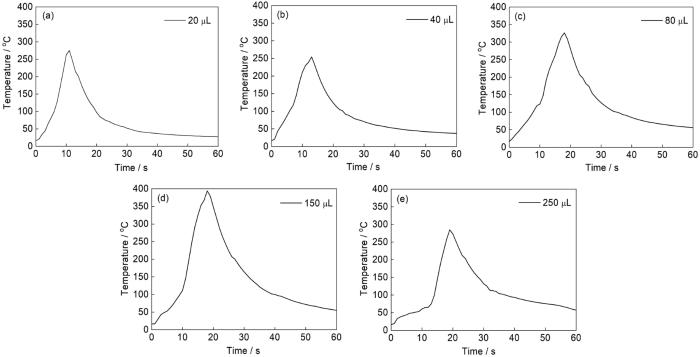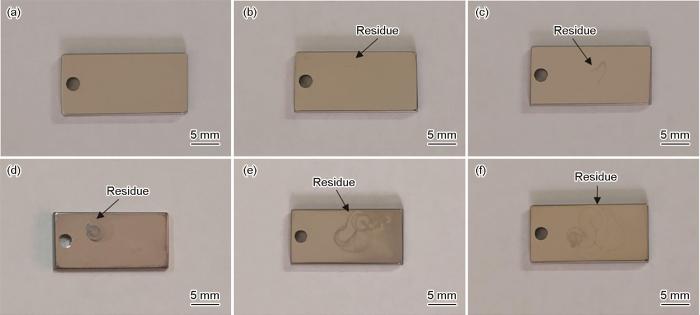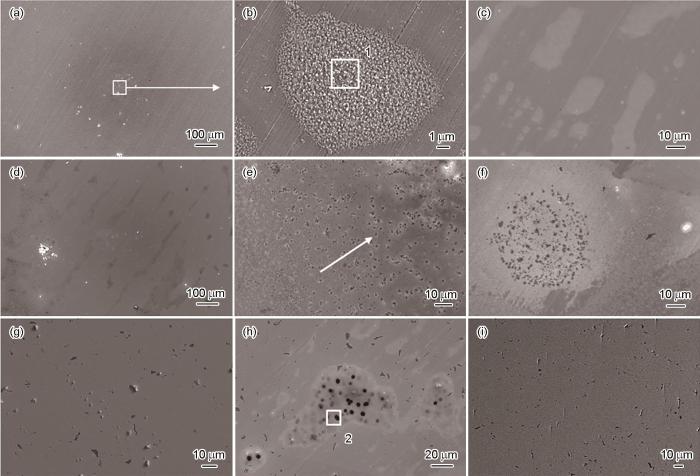在纵火案件中为达到快速放火的目的,作案人常会使用液体助燃剂[1]。火场中是否有液体助燃剂存在,是确定火灾性质的关键[2]。通常使用化学方法对火场残留物成分进行分析以确定是否有助燃剂存在[3~6]。然而,火灾现场通常会受到燃烧损毁及灭火过程中的破坏,同时助燃剂在火场环境中易挥发难寻找,火场中的木材、纤维和塑料等也会干扰成分分析[7~9]。已有的研究表明[10~14],在含有助燃剂的气氛环境中,金属的氧化温度和氧化气氛对金属的氧化有明显的影响。可以设想当泼洒在金属表面的助燃剂燃烧时形成的高温液态薄膜,将会与金属相互作用而产生高温氧化反应,不同区域不同含量助燃剂燃烧产物与金属本身性质、所处的环境及温度相关,这些结果将有助于判断是否有助燃剂存在。
本文采用研究中常被用作为汽油和柴油燃烧的替代燃料的正庚烷来模拟火场助燃剂,研究其在纯铁(Fe)表面点燃的暂态氧化过程,通过金属表面助燃剂燃烧后的氧化产物形态及结构特征,为火灾现场是否存在液体助燃剂成分提供一种新的检验方法。
1 实验方法
本研究使用材料为工业纯Fe,化学成分(质量分数,%)为:Fe 99.35,Si 0.002,Mn 0.003,P 0.0002,C 0.00025,Cr 0.001,其余0.64355。将样品加工成尺寸为20 mm × 10 mm × 2 mm的试样,然后用SiC砂纸按600、1200和2000#的顺序研磨并抛光。依次用丙酮和无水乙醇对试样进行超声清洗以去除表面油污,随后用乙醇和蒸馏水冲洗,最后用电吹风吹干后备用。实验中模拟燃烧使用的助燃剂选择正庚烷。
助燃剂界面氧化模拟实验如图1所示,实验开始时,将试样置于洁净的玻璃板上,并在样品表面固定热电偶以记录温度变化,使用移液枪准确量取实验所需的正庚烷,均匀滴落至对应样品表面,助燃剂用量分别为20、40、80、150和250 μL,液体在样品表面自然铺开,随后将正庚烷点燃,燃烧结束后,静置样品使其自然冷却。使用Zeiss Sigma 场发射扫描电镜(SEM)和自带的Oxford INCA能谱(EDS)观察氧化表面的微观结构和元素分布。使用CSPM5500原子力显微镜(AFM)分析表面颗粒分布。使用Optec MDS400金相显微镜观察金相变化,金相刻蚀的溶液为4%硝酸酒精。由于X射线衍射仪(XRD)的信号穿透深度在几微米到几十微米之间,对局部氧化的薄层表面附着物的检测效果不佳,故采用Thermo Scientific K-Alpha X射线光电子能谱(XPS)分析表面化学成分,测试前经氩离子刻蚀,刻蚀深度10 nm,以去除空气中组分对结果的影响。
图1
图1
模拟火场燃烧实验示意图
Fig.1
Schematic diagram of the simulated fire scene combustion experiment
2 实验结果
经过1 min的升温和降温,Fe在正庚烷铺满表面的氛围中经历氧化过程。样品表面的温度变化如图2所示,在不同的燃烧条件下,Fe经历了点火升温和在空气中随环境降温,不同样品表面火焰燃烧时间持续了11~19 s,金属表面燃烧最高温度范围在260℃ (20 μL)至394℃ (150 μL)之间。火焰熄灭后,样品在空气中迅速降温。随正庚烷含量增加,燃烧时间每次增加2 s,样品的表面温度先升高然后降低,温度下降的速率减慢。图3为不同含量正庚烷在Fe表面燃烧后的表面宏观形貌。可以看出,Fe表面无明显剥落痕迹,且均附着黑色残留物,残留物痕迹之间存在清晰、连续且不规则的分界线,对该区域的EDS分析结果表明,该残留物为碳。
图2
图2
不同助燃剂含量下纯Fe表面温度变化曲线
Fig.2
Surface temperatures of pure Fe in simulated fire scene combustion environment with the accelerant contents of 20 μL (a), 40 μL (b), 80 μL (c), 150 μL (d) and 250 μL (e)
图3
图3
Fe在不同含量正庚烷助燃剂燃烧环境暴露后的表面形貌
Fig.3
Surface morphologies of pure Fe after exposure in combustion environments with different contents of n-heptane: (a) 0 μL, (b) 20 μL, (c) 40 μL, (d) 80 μL, (e) 150 μL, (f) 250 μL
图4为正庚烷燃烧后的Fe表面原子力显微镜分析结果,结合宏观形貌图可见,20 μL正庚烷在金属表面燃烧后样品表面保持光滑的镜面状态(图3b),AFM结果表明,与原始试样(图4a)相比,表面分布少量颗粒残留物。增加正庚烷的用量至40 μL,Fe表面C颗粒密度增加,金属表面其他部分无明显的颜色变化。当正庚烷用量增加至80和150 μL,可以看出,金属表面C显著增多,这些C可能来自正庚烷的不完全燃烧形成的C沉积。随正庚烷用量进一步增大到250 μL,此时可见Fe表面C颗粒的密度有所下降。结合温度变化图可知,这是由于150 μL时样品表面的温度较高,而正庚烷的裂解反应是吸热反应,较高的温度促进了裂解反应形成更多的C颗粒。这说明表面的颗粒物密度与正庚烷的用量和表面温度有关。
图4
图4
纯Fe在不同含量正庚烷助燃的火场暴露后表面AFM分析结果
Fig.4
AFM results of the surfaces of pure Fe after exposure in combustion environments with different contents of n-heptane: (a) 0 μL, (b) 20 μL, (c) 40 μL, (d) 80 μL, (e) 150 μL, (f) 250 μL
图5
图5
纯Fe在含250 μL正庚烷助燃剂燃烧环境中暴露后表面XPS分析结果谱
Fig.5
XPS spectra of the surfaces of pure Fe after exposure in combustion environment with 250 μL n-heptane : (a) XPS survey, (b) Fe 2p3/2, (c) O 1s, (d) C 1s
表1 Fe在不同区域的EDS测试结果
Table 1
| Area | Element content | C | O | Fe |
|---|---|---|---|---|
| 1 | Mass fraction, % | 9.8 | 3.32 | 86.88 |
| Atomic fraction, % | 31.63 | 8.04 | 60.33 | |
| 2 | Mass fraction, % | 58.46 | 2.75 | 38.79 |
| Atomic fraction, % | 84.89 | 2.99 | 12.11 |
图6为不同含量正庚烷在Fe表面燃烧后局部氧化区域图。图6a和b为20 μL正庚烷在Fe表面氧化后的局部形貌。从图中可见,在金属表面零散分布少量块状区域,进一步放大可见该区域分布大量颗粒状物质(图6b),对位置1作EDS分析,结果表明该位置沉积了31.63%的C,这可能与正庚烷燃烧过程中的裂解有关。增加正庚烷助燃剂用量至40 μL,除图6a和b两种形貌外,还观察到大量由颗粒状C构成的块状区域(图6c)。随助燃剂含量的增加,颗粒状C的覆盖区域增加,这与宏观形貌对应。图6d~f为正庚烷用量为80 μL时样品的局部形貌,可以观察到带状区域覆盖在金属表面,EDS结果表明该物质为C,说明这些区域可能是经过裂解C的积累形成的。图6e可见在金属表面形成了大量的腐蚀坑,且坑周围均匀附着C,结合样品的金相分析可见(图7b),C更趋向于聚集在样品的缺陷和晶界处。另外,腐蚀坑沿箭头方向有扩大趋势,这是由于正庚烷燃烧时,液体在燃烧的过程中,体积收缩,由燃烧形成的气氛氧化区由边缘朝中心移动。因此,不同区域受到的氧化时间不同,这表明表面缺陷与局部氧化的时间有关。当助燃剂燃烧使液滴收缩至中心区域时,温度最高,因此在中心环形区域裂解形成了大量C(图6f)。图6g和h为助燃剂增加到150 μL后样品的氧化形貌,由图可见,除表面的颗粒物残留外,氧化区域已有非常明显的脱落区(图6g),另外在残留物覆盖区域,还可以观察到大量的残留物在坑内积累(图6h),位置2的EDS结果表明,该区域表面C含量为84.29%,远高于试样的其他区域,可以看出缺陷处更容易积累C。250 μL时样品表面的现象与150 μL时类似,只是表面脱落区域密度更大(图6i)。对比不同含量正庚烷氧化SEM图可见,随正庚烷用量和燃烧时间的增加,样品表面脱落形成的氧化坑密度增大,脱落区域的密度可能与燃烧的时间有关。
图6
图6
纯Fe在不同含量正庚烷助燃剂燃烧环境中暴露后SEM表面形貌
Fig.6
SEM surface images of pure Fe after exposure in combustion environments with different contents of n-heptane : (a, b) 20 μL, (c) 40 μL, (d-f) 80 μL, (g, h) 150 μL, (i) 250 μL
图7
图7
纯Fe在含80 μL正庚烷助燃剂燃烧环境暴露前后表面金相照片
Fig.7
Optical microscope photographs of pure Fe before (a) and after (b) exposure in combustion environment with 80 μL n-heptane
3 讨论
3.1 助燃剂在纯铁表面燃烧过程中碳的形成
在纯Fe表面,正庚烷燃烧的裂解过程,首先发生的过程是O2吸收光子能量形成游离态氧原子:
随后发生的是燃料裂解形成小分子,正庚烷吸附在金属表面,经过加氧、脱氢等反应的低温热裂解。虽然正庚烷热解涉及成百上千个反应,但初始的反应过程可以归结为4个阶段[18,19],其中主要有以下几种裂变方式。分别为C-C键的长链断裂,脱氢反应和分子内脱氢反应(内部脱去两个H,形成烯键)。键能最低的化学键首先发生断裂,初始的热解反应中最先发生的反应是长链的断裂。由于C-C键的键能最低,所以最先发生的过程是长链裂解生成C2、C3等短链小分子以及自由基。根据键能理论,反应(2)~(4)的键能在热解反应中最低,分别为362.4、365.2和366.4 kJ/mol。因此,热解中最先生成的是C2H5自由基,随后产生C3H7和CH3自由基,这一过程生成了大量的自由基和中间体。
其次,发生的是正庚烷1、2和3号位的C-H键的断裂反应,形成大量的H自由基。3种反应的键能分别为414.8、400.2和403.7 kJ/mol。
随后生成的产物主要有两条路径被消耗,第一条路径是通过C-C键裂解的过程中,产生的大量烯烃分子,同时C原子数大于2的分子会自动分解成C2H5自由基,自由基经反应(9)进一步分解为烯烃,并发生反应(10)和(11)。随后在自由基反应阶段,自由基发生断链、脱氢反应等反应生成各类烯烃、炔丙基等小分子基团。
其中,对于反应(12)气相C的活度可以表示为:
对于反应(13)气相C的活度可以表示为:
当金属暴露在还原性的渗碳气氛并在表面沉积C时,将在金属中发生局部溶解并与Fe结合产生渗碳作用。相关研究表明[26],正庚烷火焰温度主要集中于火焰的中下部,温度在500~700℃。对于渗碳体的形成反应(14),Fe3C的Gibbs自由能有以下关系:
其中,
图5d的C 1s光谱结果表明铁碳化合物的存在。这是由于产生的C与Fe发生了渗碳作用,与复杂气氛中C的活度有关。正庚烷经过上述的热解过程,在金属表面,随着单位面积下燃烧正庚烷的量增加,燃烧时间和温度上升,热解形成的C也在增加。另外,图6e可见大量的C沉积在缺陷附近,图7中可见C颗粒沉积大部分在纯铁的晶界附近,这是由于缺陷处和晶界具备高的表面能,晶界处原子排列不规律,使得C颗粒形核过程更容易被吸附在晶界和缺陷处。由于燃烧火焰的不稳定性,因此,在金属与正庚烷和空气的交界面,气氛温度一般高于金属表面温度。参考Nafe[27]建立的Fe3C与温度的活度图可知,当气氛与金属界面局部温度高于590℃时,使得热力学上局部aC达到足够大的值,表面的残留C转化为Fe-C化合物被认为是可以发生的。这表明助燃剂存在时液体燃烧气氛在低温仍可产生渗碳作用,促进了反应(14)的进行。
3.2 Fe在助燃剂燃烧氛围中的氧化机理
与少量正庚烷燃烧时的状态相比,随助燃剂增加至一定范围以上,可见金属表面形成大量缺陷。这是因为单位面积上助燃剂的含量增加,燃烧时间和温度随之增加,并且在助燃剂与金属的界面处,燃烧产生了CO、CO2、H2O及未完全燃烧的正庚烷等气氛,CO2和H2O作为氧化性物质,通过多种方式使得金属表面局部产生微裂纹,进一步促进在助燃剂和金属界面的氧化作用。
氧化性气氛在一定温度下与基体金属发生反应,并在局部产生氧化膜,同时产生的H2在局部聚集产生应力,将使得金属表面产生微裂纹,并加速破坏金属表面的结构,使得表面更容易受到侵蚀。在局部氧化性气氛的影响下,H2O还会与金属发生阴极去极化反应,在基体内生成挥发性产物FeOOH,FeOOH从氧化膜中溢出,也使得表面进一步产生裂纹[28]。局部生成的Fe3C在燃烧的气氛中存在脱C反应,产生的气体在内部积聚,增大局部氧化层与基体的应力。
另外,在金属表面液态助燃剂燃烧的过程中,由于金属表面产生的裂纹等缺陷处表面能大,将对液态助燃剂产生吸附作用。蒸发产生的助燃剂气体,裂解反应产生的气体将使得裂纹进一步拓展,从而加速表面的脱落。
4 结论
(1) 正庚烷在Fe表面燃烧时会发生裂解导致不规则C的沉积,局部的沉积C以颗粒状形态残留,此外C在金属表面的沉积量与正庚烷助燃剂的含量和环境温度相关,金属上的这些成分痕迹有利于推断助燃剂的存在性及其分布规律。
(2) 正庚烷助燃剂界面燃烧产生的局部氧化性气氛促进了Fe表面氧化物中缺陷的形成,增加正庚烷助燃剂含量会增加氧化膜缺陷的密度,从而加速氧化层的剥落。
参考文献
Key factors about fire investigation: evolving mechanism-based utilization into reverse deduction
[J].
火灾调查中的关键要素演变及逆向推演
[J].
A review of modern challenges in fire debris analysis
[J].
Analysis of fire debris
[A].
Analytical tools for the analysis of fire debris. A review: 2008-2015
[J].The analysis of fire debris evidence might offer crucial information to a forensic investigation, when for instance, there is suspicion of the intentional use of ignitable liquids to initiate a fire. Although the evidence analysis in the laboratory is mainly conducted by a handful of well-established methodologies, during the last eight years several authors proposed noteworthy improvements on these methodologies, suggesting new interesting approaches. This review critically outlines the most up-to-date and suitable tools for the analysis and interpretation of fire debris evidence. The survey about analytical tools covers works published in the 2008-2015 period. It includes sources of consensus-classified reference samples, current standard procedures, new proposals for sample extraction and analysis, and the most novel statistical tools. In addition, this review provides relevant knowledge on the distortion effects of the ignitable liquid chemical fingerprints, which have to be considered during interpretation of results.Copyright © 2016. Published by Elsevier B.V.
Automatic detection and classification of ignitable liquids from GC-MS data of casework samples in forensic fire-debris analysis
[J].
Review: Recent advancements and moving trends in chemical analysis of fire debris
[J].
The effect of volatile residues in burnt household items on the detection of fire accelerants
[J].
Evaluation of field sampling techniques including electronic noses and a dynamic headspace sampler for use in fire investigations
[J].
Investigations on oxidation and microstructure evolution of pure Cu in simulated air-kerosene combustion atmospheres
[J].
Oxidation behavior of carbon steel in simulated kerosene combustion atmosphere: A valuable tool for fire investigations
[J].
Effect of simulated combustion atmospheres on oxidation and microstructure evolution of aluminum alloy 5052
[J].
Investigating the oxidation behavior of carbon steel in fire scene: a new method for fire investigations
[J].
Effect of kerosene combustion atmosphere on the mild steel oxide layer
[J].In arson cases, accelerants were usually used by criminals to achieve the purpose of rapid arson. Therefore, fire investigators aim to determine whether accelerants was used in the fire scene. Metallic material has to react with corrosive gas around it at high temperature and the oxidation products may store the information of reactants. Accelerants present in fire scenes impart some oxidative characteristics on metallic materials. The aim of this work is to figure out the possibility to identify the presence of accelerant in a fire according to the oxidation patterns of metallic material. This paper researched the oxidation behavior of mild steel at high temperature in a simulated flame environment. The surface morphological and cross-sectional microstructural features of the samples were characterized by X-ray diffractions, X-ray photoelectron spectroscopy and scanning electron microscopy with energy-dispersive spectroscopy analysis after oxidation. The carbon in the combustion atmosphere had a carburizing effect on the metal oxide layer. It was mostly C-C, C-O and C=O of organic matter could be used as in fire investigation. Various oxidizing atmosphere composite systems promote the formation of metal oxide layers. And bidirectional oxidation mode in the oxide layer further accelerates the oxidation rate. The (wustite) FeO phase was not found in the oxide layer because of the strong oxidation of the combustion atmosphere. These results offer complementary information in fire characteristics, which combining the characterization of surface scale with traditional chemical analysis of recovering ignitable liquid residues from fire debris are expected to offer crucial information for determining the presence of combustion accelerants at a fire scene.© 2022. The Author(s).
The influence of carbon steel microstructure on corrosion layers: An XPS and SEM characterization
[J].
Investigation on arson cases
[J].
放火案件调查
[J].
Research progress on characteristics of combustion improver trace on the arson fire scene
[J].
放火现场助燃剂燃烧痕迹特征研究进展
[J].
Pyrolysis mechanism study of n-heptane as an endothermic hydrocarbon fuel: A reactive molecular dynamic simulation and density functional theory calculation study
[J].
Thermal rate constants of the pyrolysis of n-Heptane
[J].
Oxidation behavior of Q235 carbon steel in ethanol combustion gas
[J].
乙醇助燃剂燃烧环境中Q235碳钢的氧化行为研究
[J].
A detailed kinetic modeling study of aromatics formation in laminar premixed acetylene and ethylene flames
[J].
Detailed modeling of soot particle nucleation and growth
[J].
Soot formation in laminar counterflow flames
[J].
Carburization and metal dusting
[A]. CottisB, GrahamM, LindsayR, et al. Shreir's Corrosion[M].
Study on fire behavior of cardboard box and n-heptane in confined space
[J].
受限空间内正庚烷与瓦楞纸箱的火行为研究
[J].
Discussion of cementite layer formation and sooting
[J].
Rapid identification of liquid accelerant in fire scene environment
[J].
燃油火场环境中助燃剂的快速检验方法研究
[J].使用火场环境模拟设备对工业纯Cu及Q235钢在600,700及800 ℃条件下的火场燃烧环境进行暴露,通过光学显微镜对其表面的氧化物层进行观察,重点分析表面氧化层剥落特点及其原因。结果表明:与相同温度空气中暴露相比,火场燃烧环境进行暴露后两种金属材料表面的氧化物层厚度成倍增加,冷却至室温后为层状,而且有大量的开裂区域存在;工业纯Cu在煤油气氛环境中的氧化性能变化更为明显,表面氧化膜的粘附性严重蜕化,在整个实验过程中均发生明显的剥落;Q235钢在高温煤油燃烧环境气氛中生成的氧化物层粘附性和表面颜色显著不同,这与其所处环境中的气体成分密切相关。以上研究结果可为火灾现场的温度、燃烧时间及是否有助燃剂的加入提供初步的判断依据。












